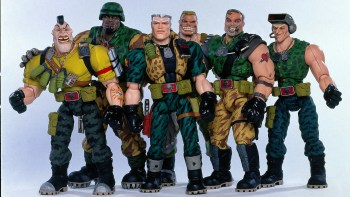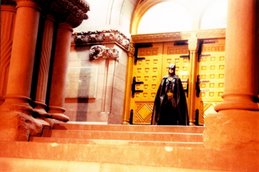Joe Dante’s Small Soldiers occupies a unique spot in his filmography. Known for blending satire with entertainment, Dante takes some bold swings here—sometimes wobbly, but always ambitious. While it may not enjoy the same spotlight as his more iconic films, Small Soldiers remains a fascinating and underrated gem that showcases his signature style in unexpected ways.
Let’s start with the most important fact: Small Soldiers is one of Joe Dante’s most underappreciated gems. Coming off cult classics like Gremlins and The ‘Burbs, Dante once again dances on the tightrope between family-friendly mayhem and gleeful satire. But here’s where things got complicated. He was originally told to make a darker, edgier film aimed squarely at teens. You know — R-rated sensibility with PG-13 restraint. But then the marketing department kicked down the door like the Commando Elite and said, “Actually, we’ve got a lot of merchandising deals lined up, so… maybe make it more of a kiddie flick?”
 “Violent, but kid-friendly? Sure, why not?”
“Violent, but kid-friendly? Sure, why not?”
And that’s the tension you feel throughout Small Soldiers. It’s not quite a kids’ movie, not quite an adult satire, but somehow the push-and-pull between those identities gives the film its unique, almost chaotic tone. This is a movie where toys blow up a gas station, disfigure Barbies into war brides, and tie up Kirsten Dunst’s character while blasting Led Zeppelin. And yet… It’s rated PG-13 and sold alongside a Burger King kids’ meal. The result? A Frankensteined tone — stitched together with commercial compromises and artistic rebellion — that perfectly reflects its story about rogue A.I. and over-militarized culture.
 Skynet Toy Edition.
Skynet Toy Edition.
But what is Small Soldiers about? The story kicks off when a shady defence contractor acquires a toy company, and the suits decide the best way to revolutionize the action figure market is to slap experimental military microchips into plastic soldiers. Enter the Commando Elite, a squad of toy-sized warmongers led by the unhinged Chip Hazard (Tommy Lee Jones), who takes his mission to eliminate the enemy — in this case, a peaceful tribe of alien-looking misfits called the Gorgonites — very seriously. Programmed to adapt, improvise, and destroy, the Commandos promptly escape their boxes and begin treating the suburbs like a battlefield.
 “If I win, I can’t be stopped!”
“If I win, I can’t be stopped!”
Caught in the chaos is Alan Abernathy (Gregory Smith), a teenage screw-up trying to help out at his dad’s failing toy store while also dodging his own disciplinary history. He persuades delivery driver Joe (Dick Miller) to give him a set of the new GloboTech toys so that his father’s “Family Friendly” toy store may turn a profit for once, thus he unwittingly unleashes toy combat upon the world. He takes action-figure Archer (Frank Langella), the noble and introspective leader of the Gorgonites, back to his house, and it is there that he discovers these aren’t just ordinary toys. The Gorgonites, who’d rather hide and learn than fight, include the one-eyed Insaniac (Michael McKean), the boulder-like Punch-It (Harry Shearer), the slow-witted but kind Slamfist (Christopher Guest), and the chameleon-like Scratch-It (also Christopher Guest) — quickly prove to be the real underdogs of the story.
 Alan had to “Dumpster Dive” to get this lot.
Alan had to “Dumpster Dive” to get this lot.
Opposing them are the rest of the Commando Elite, each voiced by Hollywood veterans: Brick Bazooka (George Kennedy), Butch Meathook (Clint Walker), Link Static (Jim Brown), Kip Killigan (Ernest Borgnine), and Nick Nitro (Bruce Dern). These guys aren’t just toys — they’re war-movie clichés brought to disturbing life. Meanwhile, across the street, Christy Fimple (Kirsten Dunst) and her little brother (Jacob Smith) get roped into the madness when her fashion doll collection — the disturbingly perky Gwendy dolls (Sarah Michelle Gellar and Christina Ricci) — are hijacked and transformed by the Commando Elite into manic plastic go-go commandos.
 “I’d castrate Ken if he had any balls to begin with.”
“I’d castrate Ken if he had any balls to begin with.”
Her dad, Phil Fimple (Phil Hartman), plays the oblivious suburbanite glued to his surround sound system, while her mom, Marion (Wendy Schaal), gets her own brush with the miniature war zone. Alan’s own parents, Stuart (Kevin Dunn) and Irene (Ann Magnuson), are also dragged into the mayhem, especially when their kitchen appliances and garden tools get weaponized. And let’s not forget the corporate stooges who started it all — Irwin Wayfair (David Cross), a neurotic, well-meaning engineer, and Larry Benson (Jay Mohr), a sleazy opportunist who had greenlit the use of Defence Department hardware in toys to meet a release deadline. To wrap things up, after a brutal battle and an EMP burst fries the Commando Elite, company CEO Gill Mars (Denis Leary) swoops in, a man who combines Steve Jobs’ salesmanship with a warlord’s ethics, and pays everyone off to forget the whole thing.
 “Who can afford ethics in today’s market?”
“Who can afford ethics in today’s market?”
Stray Observation:
• Irwin tells Larry that he was given the computer password “Gizmo”, a reference to Joe Dante’s 1984 classic Gremlins. Also, Alan’s computer is called “Piranha,” a reference to Dante’s Jaws rip-off Piranha.
• Chip Hazard addresses his troops and appears in front of the large American flag, a nod to the opening of Patton (1970).
• Four of the Commando Elite had been in 1967’s The Dirty Dozen: Ernest Borgnine, Jim Brown, Clint Walker and George Kennedy.
•
The old horror movie that the Gorgonites come across on the television,
after accidentally switching channels from wrestling, is The Crawling Eye (1958).
• The music being played during the scene where they turn the “Gwendy” dolls into soldiers is the theme music from The Bride of Frankenstein (1935).
•
Stan Winston’s team helped Hasbro create the tie-in toy line, and in a
strange twist of fate, sales for the SMALL SOLDIERS toys outperformed
the movie.
Who wouldn’t want these guys?
At its core, Small Soldiers is a scathing critique
of the militarization of youth, the blind glorification of violence, and
the dangerous intersection between entertainment and tech. This isn’t
just about toys — it’s about corporations pushing warlike ideologies
onto children under the guise of fun. Let’s not forget: the Commando
Elite are literally brought to life by “X1000” military microchips
repurposed for consumer toys. Denis Leary, in Full Sleaze Mode, even
brags, “We can make missiles that can hunt down one unlucky bastard
7,000 miles away and stick a nuclear warhead right up his ass. I don’t
think we’re gonna have a problem with this.” Sound familiar in the
era of real-world A.I. experiments? With today’s rapidly developing
neural networks and generative models, Small Soldiers feels less like a 1998 popcorn flick and more like a prophetic warning wrapped in a Nerf gun Note:
Swap “military chip” for “machine learning model,” and suddenly the
idea of toys learning on the fly, improvising tactics, and acting
according to mission parameters sounds a lot like your latest Boston Dynamics demo — only with worse customer support.
Note:
Swap “military chip” for “machine learning model,” and suddenly the
idea of toys learning on the fly, improvising tactics, and acting
according to mission parameters sounds a lot like your latest Boston Dynamics demo — only with worse customer support.
The effects in Small Soldiers
are a glorious hybrid of Stan Winston’s animatronics and
then-cutting-edge CGI, with about one-third of the visuals done with
puppetry and the rest digitally by the guys at ILM. The result holds up
remarkably well today. There’s a tangible weight to the characters,
whether they’re jumping off countertops or hijacking a JVC boom box for
psychological warfare. The fact that you feel the plastic-on-wood impact
when toys throw hands makes the action oddly visceral. It’s like
watching a toy version of Die Hard, directed by someone who knows both satire and squib placements.
 We even get a little Road Warrior action.
We even get a little Road Warrior action.
Can we talk about those Frankensteined Barbie dolls — sorry, “Gwendy” dolls? Holy uncanny valley, Batman. In one of the film’s darkest and most gleefully deranged sequences, the Commando Elite bring the dolls to life using household tools, wires, and sheer toy rage. The result is pink-haired, sadistic plastic nightmares that look like something out of Bride of Chucky’s Pinterest board. That’s the moment the movie stops pretending it’s just “for kids.” That’s the Dante touch — the horror just beneath the plastic smile.
 As a kid, Joe Dante must have been like Sid from Toy Story.
As a kid, Joe Dante must have been like Sid from Toy Story.
It’s worth noting that just before release, a lot of the action was toned down. Explosions were trimmed, jokes softened, and what was meant to be a scathing teen-oriented satire was neutered in post-production to make it palatable for the same kids who collected Burger King tie-in toys. It’s a miracle the movie’s edge wasn’t completely dulled. And yet, the genius of Small Soldiers is that you can still feel the original cut underneath. You can see Dante poking holes in the marketing sheen. You can hear the political teeth just beneath the humour. And you can absolutely enjoy the hell out of it as a smart, fast-paced, wonderfully weird action movie about warlike toys trashing a sleepy suburb.
 “War does not determine who is right – only who is left.”
“War does not determine who is right – only who is left.”
In conclusion, Small Soldiers is Gremlins with microchips, RoboCop for the PlayStation generation, and a cautionary tale for a world racing headlong into sentient technology. It’s funny, dark, loaded with clever cameos, and still boasts some of the best hybrid effects of its era. While it never got the credit it deserved (thanks, marketing department), it remains a Joe Dante classic for those who love their satire dipped in plastic and dressed in camo. “Chip Hazard out.”






































